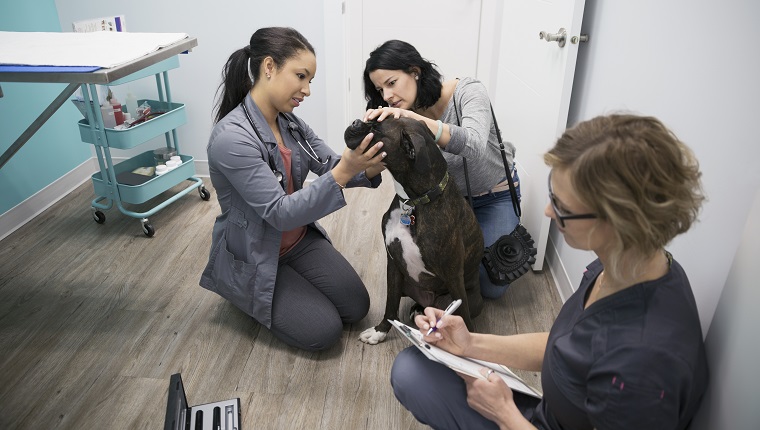Meloxicam, also known by the brand name Metacam, is a medication used to reduce pain and inflammation in dogs who suffer from conditions like osteoarthritis. Mobic is the human version of meloxicam, though it’s not interchangeable with Metacam and shouldn’t be given to dogs.
The drug is approved for use in dogs by the FDA and available with a veterinarian’s prescription. In addition to treating many conditions, it may also be prescribed for dogs after surgery to reduce pain. Follow your veterinarian’s guidelines for use with your dog strictly.
With your vet’s prescription, you can easily get your dog’s medication online through Chewy’s Pharmacy. Your pet prescriptions will be delivered right to your doorstep in less than a week. You can even add your pet prescriptions to Autoship, so you never have to remember to order refills.
Click here to browse Chewy’s Pharmacy for your pets’ health needs, and click here to buy meloxicam with your vet’s prescription!
Here is what you should know about the uses, dosage, and side effects of meloxicam in dogs.
Uses Of Meloxicam For Dogs

Vets most often prescribe meloxicam to treat dogs for inflammation, pain, and stiffness from osteoarthritis, but it can also treat symptoms of other muscle or bone disorders. It works by reducing the hormones in the body that cause pain and inflammation, and as an NSAID, it does so without relying on steroids.
Vets sometimes prescribe meloxicam to reduce pain in dogs after surgery or recent injury. The drug can treat both chronic conditions and short-term, acute pain symptoms and inflammation.
Dosage Of Meloxicam For Dogs

The following is a guideline for typical use of the drug in dogs and must not replace your veterinarian’s advice for your individual pet.
It’s important to stick to the dosage your vet recommends. Overdose could result in symptoms such as vomiting, dizziness, fainting, headache, seizures, cardiac arrest, slowed breathing, or other serious side effects.
The usual dosage of meloxicam for dogs is .09 to 0.1 mg per pound on the first day of treatment followed by .045 to 0.05 mg per pound administered orally once a day after that.
The usual strength of meloxicam is 7.5 mg per tablet, and your veterinarian will be able to give you instructions on how to measure your dog’s dosage properly. Tablets can be given with or without food, but your dog should have plenty of access to fresh, clean water throughout the day.
Metacam may come in a liquid version that can be added to your dog’s food, and your vet can advise you on which form of meloxicam is best for treating your dog’s individual condition.
Your vet may adjust the dosage based on your dog’s response to the drug with the goal of giving the lowest dose possible while still providing effective relief from symptoms.
Meloxicam is also available in a solution that can be injected. Your vet can provide further instructions on administering this solution safely.
Side Effects Of Meloxicam In Dogs

The most common side effects of meloxicam in dogs involve gastrointestinal upset, much like other NSAID medications. If symptoms become extreme or alarming, then you should contact your vet. They may wish to adjust the dosage or find alternative treatment.
Here are some common side effects of meloxicam:
- Black or bloody stool or diarrhea
- Blood in vomit
- Swelling or weight gain from fluid retention
- Increased thirst or urination
- Fatigue or weakness
- Jaundice (yellowing of skin, gums, or eyes)
- Itchiness
- Abdominal pain or tenderness
- Weight loss
- Stomach ulcers
- Behavioral changes
As with nearly all medications, there is a risk of allergic reaction that could lead to anaphylaxis. If you see the signs of an allergic reaction, including swelling, difficulty breathing, or hives, then contact your vet immediately.
Puppies or dogs who are pregnant or nursing shouldn’t take meloxicam. You should let your vet know if your dog has any other medical conditions, especially renal or cardiovascular conditions.
Your vet should also be aware of all medications your dog is taking, even over-the-counter drugs, as these can react poorly with meloxicam.
Click here to buy meloxicam for your dog with your vet’s prescription!
Pet Parents can also leverage Chewy’s telehealth service, Connect with a Vet to connect online with licensed veterinarians to answers all pet-related questions and concerns! Free to Autoship customers, Connect with a Vet lets you chat directly with a licensed vet between 8am and 11pm ET to answer questions, receive advice, discuss concerns you might have regarding the health and wellness of your pet, and even get referrals to your local vets or emergency clinics.
Check out Chewy’s Online Pharmacy and Connect with a Vet service!
Has your dog ever taken meloxicam? Did it relieve their pain and inflammation? Let us know in the comments below!






